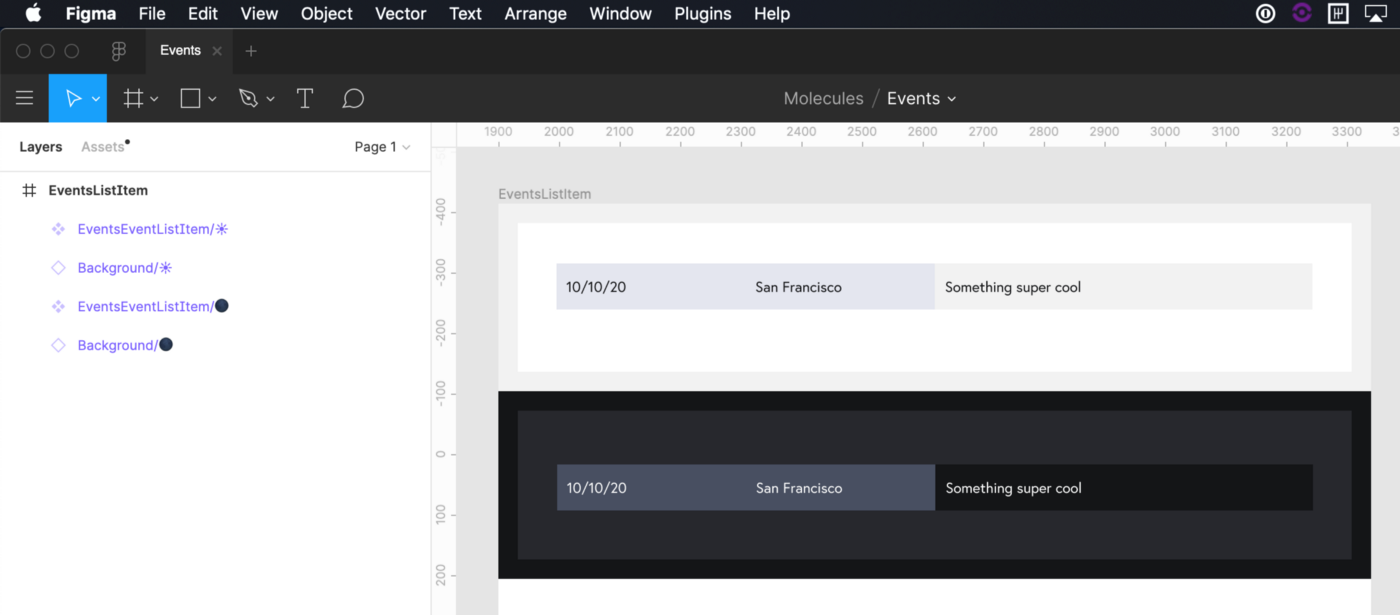- What is Component Language?
- Why care about Component Naming?
- Deductive Component Language.
- How Deductive Component Language Can Transform your Design Process, Engineering Implementation, and Documentation.
- Conclusion.

Languages are generally made up of a structured set of syntactic rules. There are spoken languages (English, etc), programming languages (Javascript, etc), domain specific slang (tech slang, etc), etc. Choosing a common language when talking about implementing design with code can be a hard thing to do. Such an idea crosses all concepts of language (spoken/programming/domain specific) and by mindfully unifying design & engineering behind a naming/organization system (“language”) you can make it easier to convey product ideas and make the process of implementing those ideas easier and faster to realize. At it’s best, “Component Language” is the process that organizes & definitively names a component in your codebase and design files. This process most likely won’t happen organically, especially on larger teams. It requires mindful structure and 100% “buy-in” from product, design, and engineering teams.

A quick google of “how to name components” will give you a few very opinionated articles (yes, including this one). Why are so many people passionate about this?It’s because component naming and organization reflect the state of product organization of an entire company.Not having a set system to name & organize your components is an indicator that your company may also have:
- Fragmented communication between product, design, and engineering teams.
When product teams talk about a “Announcement” concept, design teams call it “Banner”, and engineering teams call it whatever the person writing the ticket thinks works in the moment (probably something like “Alert”), it’s hard to keep deliverables and expectations straight. Much refactoring ensues. Much duplicate code. Much sadness.
- Difficulty navigating through the codebase & design files quickly & coherently.
This doesn’t just concern “new hires.” If you don’t have a set component organization & language, even the most familiar engineers & designers on a team will spend some time second guessing where something lives instead of being able to locate it quickly. Even worse, they might create files in places no one else would think to look.
- Lack of clarity about what a component is supposed to do.
Without a set system in place to name components, you’ll run into the possibility of creating several components that do similar things in design and engineering. In some cases this leads to duplicate silos of work that can slow down development of new features. (why build a component again?)
- A rough “Design handoff process” to engineering.
How does an engineer know what to implement if design calls it something different than what’s in the codebase? How do they quickly know what reusable components already make up that design so that they don’t make duplicate code? How does a designer know what components engineering has already made?
But enough about when things go wrong… how do we prevent these pitfalls?
TLDR;
// File Structure:
<genericGroup> / <genericGroup><functionality> / <genericGroup><functionality>.<fileExtension>// For Example:
The general idea of Deductive Component Language is that you work your way down from the most general to the most specific attributes to name your component (hence “Deductive”). This (ideally) collaborative process of coming up with a component name is important because it should encourage design & engineering to have real conversations about what a component’s intentions are. Deductive Component Language can be boiled down to asking yourself only two questions while making a component:
- What does the component generally concern?
This could be a model (like in an MVC framework) or general functionality (like “Container,” “Dialog,” or “Input”). For example, if it is a component that is generally used for your “Blog” on your website, then the answer to this question is “Blog”. This answer becomes the parent folder name where this component lives & the first part of the component’s final name. This parent-level term can be plural or singular but you should pick one or the other so that all folders have the same structure (e.g.: “Blog” or “Blogs” ). So far our component has this structure:
Blog / Blog____ / Blog____.tsx - What does this component do?
This is the hyper-specific functionality of the component. For example, if it is a component that displays all of the logic for your blog’s hero areas (on blog display pages) then the answer to this question is something like “well, it’s the Hero Area”. This answer becomes the second part of the component’s name. In the end, this component’s name & structure looks something like:
Blog / BlogHeroArea / BlogHeroArea.tsx
At the end of this system you now have a component name that tells you:
- Where the component lives.
- What the component generally concerns.
- What the component specifically does.
If you keep the generic pattern of going from the most broad to the most specific attributes and adopt specific patterns of naming, you will easily start grouping “like” components together alphabetically in your code editor. For example:
// All your dialogs are grouped in a folder and those with "create" (in this case, create="AddNew") functionality are also grouped alphabetically in a folder by your code editor:
Dialog / DialogAddNew / DialogAddNewCat
Dialog / DialogAddNew / DialogAddNewComment
Dialog / DialogAddNew /DialogAddNewTitle
// If that is too many high level folders for you, you can still nest them like:
Dialog / DialogAddNewCat
Dialog / DialogAddNewComment
Dialog / DialogAddNewTitle
Cool, so how does this concept transform your entire company? Deductive Component Language can completely transform the typically hellish design handoff process.

In Figma (for example, but this also applies to Sketch ):
Figma File = Most general attribute (Deductive Component Language Parent)
Figma Frame = Master Component (With Full, precise Deductive Component Language name)
Depending on how you group everything in the Figma left side bar, the Figma file IS the dev delivery file for engineering. If you have a designer who is also an experienced engineer, then you can scope out engineering implementation git issues based on named groupings and instances of a master component.
If the Figma file has everything needed for implementation (styles, component groupings) then implementing the component is a no brainer.
A Figma → App translation is:Figma File = Component’s parent folder (Deductive Component Language Parent)
Figma Frame & Master Component = Specific component folder & component names
For Example:
Events / EventsListItem / EventsListItem.tsx
Since the names & organization are the same between Figma & the app, Figma is great to look towards as a source of documentation. However, for developers, we love platforms like Storybook that allow us to poke around at components to see how they work. If you’re using Storybook, (you guessed it) then you’d organize your components the same way as in the app:
A Basic Figma/App → Storybook translation is:Figma File = Storybook Left Sidebar Header (Deductive Component Language Parent)
Figma Frame & Master Component = Storybook top level Folder
Having a unified system for naming and organizing your components in your app, design, and documentation is key to keeping design and development efficient. Deductive Component Language is a great way to encourage open conversations between design & engineering to ensure components have specific functionality and everyone is on the same page on the direction of the app. However, any system can only be good as long as it is a collaborative, well-documented, and easy-to-follow process.

updates and news
Join our mailing list